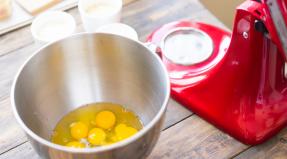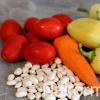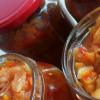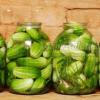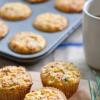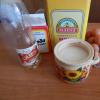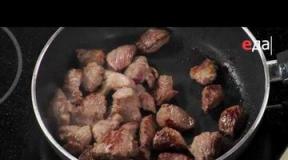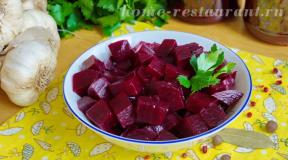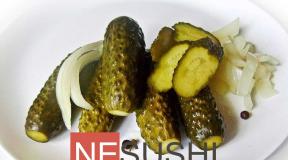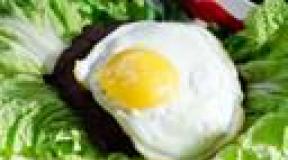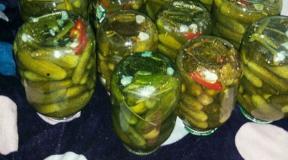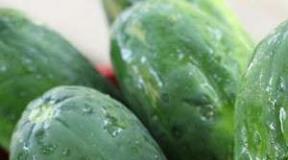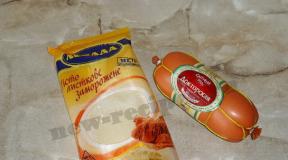Pickled cucumbers are not for the winter. Sour pickled cucumbers
The theory of ideal snacks, I do not remember who formulated (maybe even me), believes that the snack should be simple. Snack should be available and timely. It should be delicious. And the pickle from it, should treat in the morning that which is popularly referred to as "bodun".
Under this theory, ideally fit: sauerkraut - the most ideal appetizer, - I love them, as well as sauerkraut.
During my childhood my grandmother in the village in the summer salted and smelled all sorts of garden vegetables, including cucumbers. In the village of cucumbers sowed a little - some a couple of hundred. With constant care, weeding, pest control - the crop of cucumbers was always excellent, even in spite of raging phyto-sores. Cucumbers salted in a huge oak barrel, I can not even remember how big it is. I was small then, and the barrel seemed to me just huge! And in the winter, pickled cucumbers were dug out of the barrel with a bare hand, and used just like that, and as a snack under a fiery rural pervak.
I still can not reliably figure out how to properly - sour, salt or something else. Apparently, nevertheless, sour.
Salting - a way to preserve food by preserving in salt - dry, or in the form of brine. Increased salt content kills germs, thereby preserving the product for a long time. Cucumbers are salted, just pouring them with saline and keeping them in barrels for a very long time. Salted cucumbers do this (I don’t like them since childhood). As soon as the cucumbers salted, they became salted, they were immediately eaten.
Marinovka - pickled cucumbers with vinegar and canned. Also a product for everybody.
In my opinion, the best way to preserve cucumbers is pickling. Actually pickled cucumbers is a combination of salting and fermentation. So they did in my childhood. The essence of fermentation is the formation of lactic acid, which has preservative properties. Exquisite taste of pickled cucumbers is provided with lactic acid.
Pickled cucumbers can be stored in the cellar in oak barrels. But in the conditions of a city apartment it is better to preserve them after fermentation. So still my mother does, rolling up in pickled cups of pickled cucumbers, which stand on the shelf, at room temperature, in a cloudy brine, and never spoil and do not “blow up”. Amazing process.
And in the winter, as needed, pickled cucumbers are used: just like that, and as a snack, and in, and even you can cook meat or.
Pickled cucumbers in banks. Delicious!
Ingredients (8-10 cans)
- Cucumbers 8 kg
- Pickling "broom" 1 bundle
- Garlic 3 heads
- Salt stone neodirovaniya taste
- In the home canning pickled cucumbers can be divided into three stages. Salting, canning, drinking.
- Of course, the most enjoyable - use. It's hard to argue.
- First you need to choose cucumbers. Small and green cucumbers, of a pleasant green color and black pimples, are best suited. For some reason, it is believed that cucumbers with white pimples are not suitable for pickling. I did not check, I confess. Hollow and bitter cucumbers are not salting, you can spoil everything. It is important that the size of cucumbers allowed to put them in a liter jar, and quite tightly.
- Cucumbers must be sorted out, removing tails, damaged fruits and any garbage. Next, wash the cucumbers well. Very thorough and under running water. Cucumbers must be soaked in cold water for several hours. Then rinse again.
- It is necessary pickling "broom". Its composition is the subject of endless discussions. But, as experience shows, the grannies at the local market will advise on this issue at the academic level. Usually, the “broom” includes whole stems of ripe dill (along with seeds), a currant branch with leaves, fennel, sometimes an oak twig, and almost always a cherry branch. Mandatory component - horseradish leaves. Usually such a broom is sold either fresh or dry. What actually salting is almost indifferent. Broom should be washed and cut into large pieces - pieces like the width of the palm.
- Garlic, of course, young - this year. Clean all the teeth from the husk and wash.
- Lead cucumbers better in the barrel. But if you are going to pickle cucumbers and then canned in jars, then you can use the usual enamelled bucket. A bucket should be placed in a large and deep bowl - a basin.
- Lay tightly cucumbers in a bucket, pouring peeled garlic cloves.
- On top of the bucket, you should leave a space approximately the width of your palm. And on top of the lay chopped and washed pickling broom.
- Next begins the process of salting. In the usual three-liter jar pour ordinary water. Room temperature. The bucket will need 1.5-2 cans. Pour 6 (six) tablespoons of iodized salt in each jar. Salts - without slides. It's hard for me to say how much it is in grams, look at the photo. But, an important point, do not overdo it, otherwise it will not pickle, but salting. Just today they were finishing conservation, a neighbor came to “clarify” the amount of salt, because last year overdone. Update: I did not immediately realize just weigh - weighed. It turns out that 6 of those spoons of salt were 120-130 grams.
- Salt mix in water until completely dissolved. Pour the brine into a bucket of prepared cucumbers. It is necessary that the brine completely covered cucumbers and partly "broom".
- Cover the cucumbers with a flat circle or an inverted plate. And load up! Yes, it is not necessary to put a pound kettlebell on top, so you can crush cucumbers. A three-liter can of water is enough.
- Now push the basin with the bucket into a corner, away from the sun and light. And forget about cucumbers for 4 days.
- If it is hot in the room, it will be very quick to pickle, and most likely three days will be enough. By the way, in a day cucumbers will be salted, and they can already be “tried”. But do not get carried away!
- As a result, the taste of cucumbers should be - still salted, but they have already begun to sour. Something mean. The cloudy white color of the brine will indicate that the lactic fermentation is successful.
- On the 5th day we start canning.
- I recommend using liter jars. Very comfortably. Suitable size. The remains of pickling broom, garlic - throw away. Pickle the brine from the bucket and drain it into a large enamel pan. Put the pot on the fire. Attention! Watch out for foaming. Foam rises there quickly. Foam should be removed with a wooden spoon.
- In the meantime, cucumbers spread out in banks.
- As soon as the pickle boils - pour into banks with cucumbers.
- Brine spill on cucumbers to the top.
- Next, cover the banks with a clean towel and leave for 7-8 minutes.

Cherry tomatoes differ from their large counterparts not only in the small size of berries. For many varieties of cherry characteristic unique sweet taste, which is very different from the classic tomato. Anyone who has never tried these cherry tomatoes, with his eyes closed, may well decide that he is tasting some unusual exotic fruits. In this article I will talk about five different cherry tomatoes, which have the sweetest fruits of unusual colors.
Salad with spicy chicken, mushrooms, cheese and grapes - fragrant and nourishing. This dish can be served as a main course if you are preparing a cold dinner. Cheese, nuts, mayonnaise - high-calorie foods, in combination with spicy fried chicken and mushrooms it turns out a very nutritious snack, which is refreshed by sour-sweet grapes. The chicken fillet in this recipe is pickled in a spicy mixture of ground cinnamon, turmeric and chili powder. If you like food with a twinkle, use hot chili.
The question of how to grow healthy seedlings, all gardeners are concerned in the early spring. It seems that there are no secrets here - the main thing for fast and strong shoots is to provide them with warmth, moisture and light. But in practice, in the conditions of a city apartment or a private house, this is not so easy. Of course, every experienced gardener has his own proven method of growing seedlings. But today we will talk about a relatively new assistant in this business - the propagator.
The task of indoor plants in the house is to decorate the house with its appearance, to create a special atmosphere of comfort. For this we are ready to take care of them regularly. Care is not only watering on time, although it is important. It is necessary to create other conditions: suitable lighting, humidity and air temperature, to make a correct and timely transplant. For experienced flower growers there is nothing supernatural about this. But beginners often face certain difficulties.
Gentle chicken breast cutlets with champignons can be prepared simply according to this recipe with step-by-step photos. There is an opinion that it is difficult to cook juicy and tender cutlets from chicken breast, it is not so! Chicken meat contains almost no fat, which is why it is rather dry. But if you add cream, white bread and mushrooms with onions to the chicken fillet, you will get awesome tasty cutlets that both children and adults will like. In the mushroom season, try adding forest mushrooms to the mince.
Beautiful garden, blooming throughout the season, it is impossible to imagine without perennials. These flowers do not require such attention as annuals, are frost-resistant, and only sometimes need a little shelter for the winter. Different types of perennials bloom not at the same time, and the duration of their flowering can vary from one week to 1.5–2 months. In this article, we propose to recall the most beautiful and unpretentious perennial flowers.
Get from the garden fresh, environmentally friendly and fragrant vegetables seek all gardeners. Relatives are happy to take home-cooked meals from their potatoes, tomatoes and salads. But there is a way to demonstrate your culinary skills with even greater effect. To do this, it is worth trying to grow several fragrant plants that will give your dishes new tastes and aromas. What greens in the garden can be considered the best in terms of culinary?
Radish salad with egg and mayonnaise, which I prepared from Chinese radish. This radish in our stores is often called Lob radish. Outside, the vegetable is covered with a light green skin, and in the cut was a pink flesh that looks exotic. It was decided when preparing to focus on the smell and taste of vegetables, and make a traditional salad. It turned out very tasty, no “nutty” notes, we did not catch it, but it was nice to eat a light spring salad in winter.
The graceful perfection of shining white flowers on high stalks and the huge shiny dark leaves of euharis give it the appearance of a classic star. In room culture is one of the most eminent bulbous. Few plants cause so much controversy. In some, euharises bloom and delight completely effortlessly, others for many years do not let out more than two leaves and seem stunted. Amazon lily is very difficult to rank as unpretentious plants.
Kefir pudding fritters - delicious pancakes with mushrooms, olives and mortadella, which are easy to prepare in less than half an hour. There is not always time to cook yeast dough and turn on the oven, but sometimes it will want to eat a slice of pizza without leaving the house. In order not to go to the nearest pizzeria, the wise housewives came up with this recipe. Fritters like pizza is a great idea for a quick dinner or breakfast. We use sausage, cheese, olives, tomatoes and mushrooms as stuffing.
Growing vegetables at home is quite a feasible task. The main thing - the desire and a little patience. Most greens and vegetables can be successfully grown on the city balcony or kitchen window sill. There are advantages compared to growing outdoors: in such conditions, your plants are protected from low temperatures, many diseases and pests. And if you have a loggia or balcony glazed and insulated, then you can grow vegetables almost all year round.
We grow many vegetable and flower crops in a seedling way, which allows us to get an earlier harvest. But it is very difficult to create ideal conditions: the lack of sunlight for plants, dry air, drafts, delayed watering, soil and seeds may initially contain pathogenic microorganisms. These and other causes often lead to exhaustion, and sometimes to the death of young seedlings, because it is most sensitive to adverse factors.
Thanks to the efforts of breeders in recent years, the range of coniferous perennials has been supplemented by a number of unusual varieties with yellow needles. It seems that the most original ideas that landscape designers have not yet been able to bring to life, just waited in the wings. And from all this variety of yellow-coniferous plants you can always choose the types and varieties that are best suited for the site. We will tell about the most interesting of them in the article.
Chocolate whiskey truffles are homemade dark chocolate truffles. In my opinion, this is one of the most simple and delicious homemade desserts for adults, unfortunately, the younger generation can only lick at the side, these sweets are not for kids. Truffles are made with different fillings, stuffed with nuts, candied fruits or dried fruits. Roll in biscuit, sand or nut crumbs. Based on this recipe, you can make a whole box of assorted homemade candies!
Harvesting cucumbers for the winter is probably one of the most common among hostesses. However, the process is not at all simple and requires an instinct, as well as special attention. Pickles for salting should be small - then they fit in a jar. Young and small cucumbers have a sweetish taste, and there are no voids inside, so they will crunch. Peel should be with black thorns and pimples. But smooth and with white thorns are more suitable for salads. If the right approach to the choice of vegetables, use clean water, and also take into account some tricks, tasty and crispy cucumbers will delight the whole family in the winter. Cucumbers for the winter are sour-sweet, sour, fermented. To make pickled cucumbers sour, you just need to add citric acid to the pot. In this article we will look at the most common and successful recipes cucumbers.
Recipe for sour cucumbers for the winter

- fresh cucumbers;
- water;
- 2 tbsp. salt with a slide on each jar (3-liter);
- sprigs of inflorescences dill;
- black peppercorns;
- garlic;
- horseradish leaves;
- vodka;
- tarragon;
- 1 PC. acetylsalicylic acid on each jar.
Adding tablets to cucumbers in this recipe is a follow up of an old tradition. Cucumbers sour for the winter is a very tasty and healthy snack.
- At the very beginning, wash and sterilize the jars thoroughly. Wash the cucumbers and cut the tails on both sides.

- Place dill inflorescences, horseradish leaves, garlic, peppercorns, 2 tbs. l salt and tarragon. At the request of the hostess salt, instead of pouring into the jar, you can add to the water, which you will pour cucumbers. Beautifully put cucumbers in jars.

- Fill with cold water, cover with lids and leave the jars for 3 days so that the cucumbers are soaked in brine, and also all the bitterness is gone. Put the jars on the tray or in bowls, because the liquid will flow out.

- After 3 days, carefully pour the brine into the container in which you will boil it. Be careful not to drain the precipitate formed at the bottom of the cans together with the brine. Boil the brine. While it boils, rinse the cucumbers from the cans under running water. Sterilize the caps. Add one tablet of aspirin and 1 tbsp. l vodka in every jar. Pour the cucumbers in the pot with boiled pickle. Spin the caps. Wrap in a blanket and leave for a day until cool. Clean the cellar or other cold place.

Sour cucumbers with a pleasant crunch ready!
Pickled cucumbers - a recipe for experienced hostesses
One of the great methods of cucumber conservation is pickling. Russian traditional method of preparation makes it possible to get vegetables of amazing taste.

- 8 kg of fresh cucumbers; rock salt (not iodized); 3 heads of garlic; currant leaves; dill umbrellas; oak branches; cherry branches; fennel; horseradish leaves.
- Loop the small cucumbers (with pimples). Remove the tails on both sides, rinse thoroughly. After that, pour cold water for several hours and rinse again.

- Rinse all the greens and chop it large. Peel and wash the garlic cloves.

- Take the enamelled bucket or other container, put it in the basin. Put cucumbers in a bucket tightly, pouring garlic over them. Spread the greens on top, leaving a place to the edge of the bucket wide in the palm of your hand.

- Pour water (room temperature) into a 3-liter jar. Pour in 6 tablespoons of salt (without a slide) and stir until dissolved. Pour the water to the cucumbers in a bucket. Fill one more can in the same way and repeat. As a result, cucumbers should be completely covered with water, and the greens - partially.

- Put the plate on vegetables with herbs in a bucket so that it covers everything. From above - as a load, install a 3l jar filled with water. Clean the bucket in a dark place without direct sunlight for about 3 days. Muddy white color of brine speaks about lactic fermentation.

Throw out all the greens from the bucket on day 4. Strain and boil the brine again, removing the foam.
- Put the cucumbers in 1-liter jars, pour the brine to the brim, cover with clean gauze or a towel and leave for 8 minutes. Pour the whole pickle back into the pan and bring to the boil again. Sterilize the caps.

- Pour the boiled pickle to the brim. Cover and seal.

- Turn the jars, wrap the blanket and leave to cool completely. Clean in a cold place where they can be stored for over a year.

Pickled cucumbers in a jar is an excellent snack, as well as a component of many salads and dishes.
We add vinegar so that our preparations are well preserved. But such cucumbers, as every mother knows, are not very useful and allowed for babies. After all, vinegar is a harmful seasoning for children's stomachs.
For seeding pickled cucumbers we need:
- cucumbers 2 kg.
- dill umbrella
- 3-4 piece cherry leaf
- black currant leaves 3 pcs.
- horseradish sheet
- black pepper 5-7 pcs.
- salt 3 tbsp with slide
- sugar 2 tsp
- mustard beans 1 tbsp.
- 2-3 garlic cloves
Pickled cucumbers for the winter in banks, without vinegar - a step by step recipe:
We will prepare all the necessary leaflets, rinse them under running water.
Put the umbrella of dill, cherry leaves, currants and horseradish in a three-liter jar. 
Now we wash cucumbers. I prefer to take small and medium fruit for seaming. 
Cucumbers on both sides cut tails. 
After that, put them in a jar, tightly to one another. 
Sprinkle sugar, salt, pepper and bitter pepper, mustard seeds and cloves of garlic peeled on top of cucumbers. Mustard seeds will give the cucumbers elasticity and will be crispy. 
Next, pour our cucumbers with cold, filtered water, close the lid, turn them a couple of times so that the salt and sugar are evenly distributed in the water, otherwise they will settle on the bottom and the cucumbers that are from the bottom will be salted, and on top they are not salted. After that, be sure to remove the cover. 
Leave the cucumbers sour for three to four days, while under the jar you must substitute a bowl or a plate, in case the brine flows out. 
After souring, pour the brine into an enamel saucepan and set on fire, boil for 10 minutes. 
Pickled cucumbers take out of the jar and packaged in one-liter jars, necessarily pasteurized over steam. Spices, we no longer put, only cucumbers. 
Pour cucumbers with hot pickle and leave for 30 minutes. Then the brine is again drained and boiled for 5 minutes. Pour the cucumbers again and leave for 30 minutes. The third time, the brine is drained, boiled for 5 minutes, pour cucumbers and rolls the lids. Wrap for 2-3 hours and remove for storage.
Pickled cucumbers for the winter in the banks, ready. They are very tasty without vinegar. 
After we get the jars out of the heat and turn them over, the brine may still be muddy, but after a couple of days it will give a sediment and settle on a cucumber with a white bloom. There is nothing terrible in it, this is the norm for cucumbers, so squeezed in this way. 
Bon appetit to you and your children.
I have already told you, and now I will tell you how to close pickled cucumbers for the winter. And in the winter ... in the winter we will cook pickle, make a vinaigrette, add them to the pizza, and they are simply divine with fried potatoes!
So, we go to the garden, pick cucumbers (or buy them on the market), soak them for an hour, but in the meantime, wash our jars and clean the garlic (remembering that, like butter, we will not spoil cucumbers with garlic). The longer everything is as usual: we put dill and garlic on the bottom of the jar, add cucumbers.
For starter, it is better if the cucumbers are slightly overgrown (but not old!). By the way, that's why I love exactly the fermented ones - because you don't have to choose cucumbers every day!
And I cannot choose them every day for ideological reasons, because I:
- lazy
- very busy working lazy
- kind and conscientious lazy - well it turns out: the cucumbers were just born, they did not see life, they were not warmed by the sun, they didn’t care for the wind, they were not drunk with dew, and I didn’t want them either!
Ingredients
- cucumbers - 2 - 2.5 kg (depending on the size, and hence the density of laying);
- salt - 2 tbsp. with a big slide;
- water - 1 - 1.5 l (depending on the size of cucumbers and the density of their installation);
- dill, garlic and other spices to taste and availability
Cooking method
Step 1
In general, slightly zaterevshie, in the very prime of cucumbers we put in a jar, after cutting off the tips. The longest can be cut in half. Top again put a sprig of dill.
Step2
We pour two spoons of the most ordinary large table salt with a slide. 
Step3
Fill with cold water under the neck. Usually I pour water straight from the tap. 
Step4
After that, "forget" about our cucumbers of the day for 3-4. At this time, they will be safely brewed, with foam being formed on the surface. As soon as the process is completed and the foam falls off, you can proceed to the second stage. By the way, during all this action the brine can flow. It doesn't matter to me: the cucumber bottles stand right on my grate in the bathroom, still everyone uses a summer shower outside. Those who do not have a soul will have to either urgently build a shower, or put some dishes, such as a tray or plates, under the banks. In general, there are many options: you can just periodically wash the floor or another surface where they stand there, you can wash it all once after work, you can not wash it at all - salt crystals, drying out, form the original pattern ... In short, life is just Therefore, it is beautiful, which does not let us be bored, forcing us to choose among a multitude of options.
Step5
When cucumbers stop roaming, it’s better for insurance to let them stand for at least 10 -12 more hours. The fact is that if the process is not yet completed, the banks will explode after some time.
By the way, if you really forget about them for 2-3 days, nothing terrible will happen: cucumbers will simply become more sour. But you can not forget more: they can turn into a mess.
Step6
If you really forgot about cucumbers for a day or two, a small film of mold forms on the surface. Do not worry: we remove it with a spoon, and wash the dill with cold water. 
Step7
Then everything is quite simple: pour the brine into the pot, add about a quarter cup of water (instead of the one that has been absorbed, evaporated, flowed out), bring it to a boil, and quite boiling, pour it back into the bottle, close it with a pre-scalded lid. By the way, the pickle will be rather muddy and unsympathetic, but surprisingly fragrant!
Step8
Then everything is as usual - we turn over the cans, wrap them up warmerly and hold them for 10 - 24 hours, put them in storage and look forward to the winter. 

